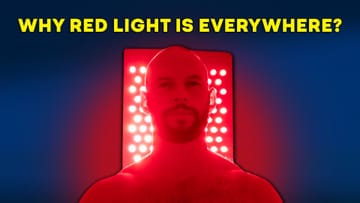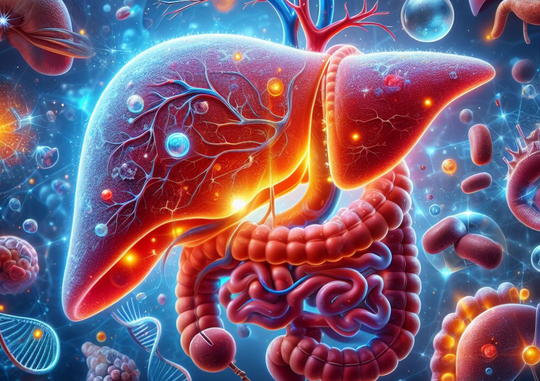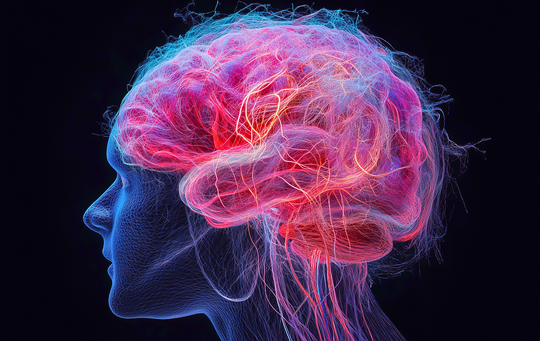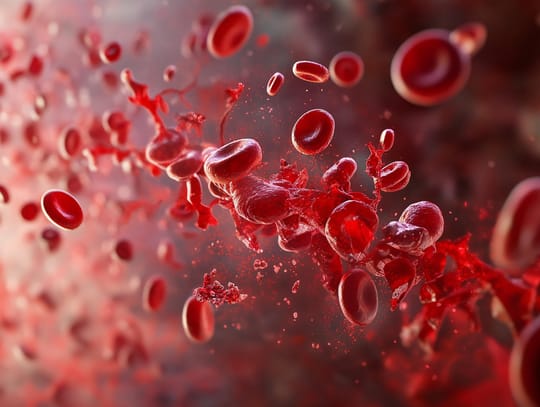Diabetes is one of the top 10 causes of premature death on this planet and massively increases your risk of other diseases, such as heart conditions and Alzheimer's. The number of people with diabetes is also expected to grow until 2050.
Diabetes is bad in and of itself too...
Type II diabetes quietly steals joy and energy from life. Your body becomes resistant to insulin so that sugar builds up in your blood instead of fueling your cells. You might feel constantly tired, thirsty, or numb in your feet, but that’s only the surface.
And, as explained before, your risk of getting other diseases goes up as well. Fortunately, there's also light at the end of the tunnel. The impact of lifestyle and nutrition has become increasingly clear over the last few decades. Exercise, dieting, movement, stress management, and other tools can all massively influence whether you get type II diabetes and how it influences you.
Nevertheless, we need new tools to deal with the problem. Red light therapy is that tool! This article explains how red light therapy can aid in managing diabetes, including blood sugar regulation. I'll also cover the best devices for diabetes, as well as how to use them effectively.
Short on time? Just read the summary below:
Some recent medical studies show that red light therapy can improve insulin sensitivity (how well your cells take up "sugars" from the bloodstream using insulin) and lower blood glucose spikes after meals. For instance, shining 670 nm red light at the back lowers blood sugar levels by a whopping 27.7%! The light was applied after a meal.
Other studies have shown beneficial effects with the application of 830 nm near-infrared light to the legs and 630 nm red light, which is directly emitted into the bloodstream. Near-infrared light reduces blood sugar levels, while red light boosts blood flow and mitigates the damaging effects of high blood sugar.
Review studies, which integrate earlier medical evidence, show that red light therapy can help with neuropathy, for instance, as well as diabetic ulcers, eye problems, and other conditions. However, there's far more high-quality evidence needed here. As always, further research is needed on the optimal wavelengths used, treatment frequency, power output, areas of the body treated, and other relevant factors.
I will give some suggestions for devices later on in this article. I consider red light therapy for diabetes very safe, but do ensure that you slowly build up your exposure and monitor the outcome. And, never forget other super important factors for diabetes management and prevention, such as daily movement, exercise, nutrition, stress management,improving your sleep quality, and more.
If you need an introduction to what these terms mean, check the following resources:
- What Is Red Light Therapy?
- Red Light Therapy Explained: Basic Terms Guide
- Start Here - Light Therapy 101 & Buyers Guide
- Red Light Therapy Dosing Chart: The Raw Data From Hundreds Of Studies
- Red Light Therapy Dosing: Why It's Complicated!
- Red Light Therapy Wavelengths Benefits: The Ultimate Guide
- How Often Should You Use Red Light Therapy Explained
These resources should give you a basic understanding of how red light therapy works, and the discussions around it!
The picture at the top of this article is AI-generated, though!
A Quick Intro: How Red Light Therapy Affects The Body In General
So I've explained in great detail in the past how red light therapy works. You can read some basic guides on the topic below, if you're not familiar:
- What Is Red Light Therapy?
- How To Use Red Light Therapy 101: The Best Guide For Starters
- Red Light Therapy: What’s The Ideal Distance from Skin?
The basics idea is that the light doesn't just hit your skin but actually ventures into your body. I'm talking about red and near-infrared light here, primarily. That red and near-infrared light then affects your body at the cellular level.
Red light therapy has tons of different effects on your body, such as:
- Increasing energy production becuase the light hits the mitochondria and increases energy production there (1; 2; 3).
- Lowers both local and systemic inflammation - which is intertwined with lower energy production and many chronic health conditions (4; 5; 6). Almost any health condition you can imagine, such as heart disease, neurodegenerative conditions, problems with your organs such as the lungs and kidneys, are intertwined with excess inflammation.
- Changes gene expression (what parts of genes are activated or not) and transcription factors (7; 8; 9). These transcription factors are partially responsible for the long-term effects of red light therapy, so that a single session of light therapy can often have effects that last for weeks or months.
- Activates stem cells, helping them differentiate (10; 11; 12). Stem cells are the "primordial" cells of your body that can differentiate into more specific cells that have more specific tasks. That way, red light therapy can help promote better health and repair mechanisms.
- Boosts your blood flow (13; 14; 15). Microcirculation is enhanced, which is circulation at the lowest level. That way, nutrients can more easily reach your cells while waste products are removed.
- Impedes pain (16; 17; 18). You'll generally need higher doses for this, but I've written about many different topics in relation to pain here, such as fibromyalgia, or knee pain, osteoarthritis, and others!
- Is neuroprotective and helps maintain nervous system health (19; 20; 21; 22; 23). This is a benefit for people with type II diabetes simply because peripheral nerve issues, such as in the feet and lower legs, is a frequent problem associated with the condition.
- Modulates the immune system
Yes, other mechanisms exist, but these are the basics. I've explained these somewhat extensively because all of the mechanisms I've mentioned above are important for diabetes, especially type II!
Next up, let's consider the most critical question:
Can Red Light Therapy Help With Blood Sugar Control?
The answer here is "heck yes!!". A very exciting recent study came out on 670 that was applied to the back of study participants (24; 25). The study participants ingested glucose as part of a glucose tolerance test.
The goal of that test is to measure how well your body deals with glucose that you ingest. If you have good insulin sensitivity, the glucose will be taken up in your cells. If you have poor insulin sensitivity, instead, the glucose will stay in your bloodstream longer.
High blood sugar levels wreck your overall health over time (26; 27; 28). So ideally you'll have very good insulin sensitivity (literally the opposite of type II diabetes), so that your cells take up the blood sugar.
Now, back to the study I just talked about. Here's what researchers state about the outcome of the study:
"A 15 min exposure to 670 nm light reduced the degree of blood glucose elevation following glucose intake by 27.7%, integrated over 2 h after the glucose challenge. Maximum glucose spiking was reduced by 7.5%. Consequently, [red light therapy] with 670 nm light can be used to reduce blood glucose spikes following meals. This intervention may reduce damaging fluctuations of blood glucose on the body." (24)
Overall, the total area under the curve of the blood sugar decreases, as does the maximum peak. That's great news. Here you can see the outcome of the study, with the intervention group receiving 670 nm light to the back:

The researchers also state that:
"Single exposures to 670 nm light can be effective within 3 h and can have impact for up to 5–7 days " (25).
So red light therapy likely has long-term effects. The problem here? Most human beings don't get any light exposure during the week! Many people spend up to a whopping 95% of their time indoors (29; 30; 31).
From an evolutionary standpoint - or just comparing yourself how hunter-gatherer societies are living - that's total lunacy. The main reason light therapy works well for people is likely that humans no longer receive any natural light exposure in their daily lives really well.
That dynamic has completely changed since the Industrial Revolution. Before that revolution, almost all humans lived outdoors and received natural light exposure in their daily lives. After that revolution, humans moved indoors more and more, and therefore didn't receive any significant light exposure during their daily lives.
However, let's return to the study (25). The study participants took 75 grams of glucose, which is a very fast-acting carbohydrate and thus perfect for testing insulin sensitivity as it quickly raises blood sugar. The intervention group (not the placebo group!) got the light exposure 45 minutes before consuming the glucose.
So there's a hint in that fact: for the best results, you may need to expose yourself to light before your meals that contain higher amounts of carbohydrates. Here's the light exposure method:
"During the participants second visit an intervention was undertaken prior to [Oral Glucose Tolerance Test] measurement. In the 670 nm PBM group, immediately following initial blood glucose measurement, participants exposed an 800 cm2 region of upper back to 670 nm light for 15 min at an intensity of 40 mW cm−2 (28 800 J). This would illuminate skin cells and underlying musculature including the trapezius . Light was delivered via light emitting diodes (LED); 670 nm peak wavelength with a half power band of ~10 nm (Light Power Health, UK)." (25).
So only a very small area of the body, the trapezius muscle on the upper back under the participants' neck, was exposed to the light! That fact immediately begs the question: What would happen with full body exposure? Would the participants receive even better blood sugar control?
Almost always, full-body treatment is better than just focusing on a small area. I've written about this topic in my article about the systemic effects of red light therapy. Yes, treating a small area has benefits for other areas of the body but direct treatment often leads to much better results.
There are some other issues with the study as well, such as:
- Ideally, you'd want this experiment repeated for confirmation. One swallow doesn't make a summer, and one study isn't definitive.
- You'd want to know whether full-body treatment is better than treating just the area under the neck with light. Yes, as stated before.
- Also, you'd want to use other treatment parameters, such as more or less power output, different wavelengths (such as the near-infrared that penetrates deeper), and so forth!
- You'd want to test the light exposure at different times, such as two hours before a meal, during a meal, or even 30 minutes or an hour after a meal, to see if the impact is noticeable.
Nevertheless, the landmark study I've just considered is extremely promising for diabetes (25). What most people don't know, however, is that there are tons of other studies on this topic.
So I'll explore other red light therapy for diabetes studies below:
Other Red Light Therapy Benefits For Diabetes
So let's consider other benefits, such as red light therapy, insulin resistance, and more! I've used Vladimir Heiskanen's Excel sheet, which contains over 8,500 studies on red light therapy, for this purpose (32). There are just under 30 studies on red light therapy for diabetes in that Excel sheet (32).
Heiskanen has categorized the studies here under the "diabetes mellitus" header! These studies can be classified into human, animal, and in vitro (Petri dish) studies. I'll skip the animal and Petri dish studies here as the reviews take these studies in sufficient account. Reviews aggregate and integrate earlier evidence on a topic, including animal studies.
I'll begin with human studies as these have the best evidence base:
Human Studies
Besides the 670 nm study I've already discussed earlier, here's the rest of the human evidence:
- First, there's an 830 nm study in people with type II diabetes (33). Here's the exciting study outcome - although somewhat complicated:
"Capillary glycemia was assessed after overnight fast (pre-prandial) [ - which means before a meal], 1 h postprandially (standardized meal, 338 kcal), and 30 min, 3 h, 6 h, 12 h post-[red light therapy treatment] (830 nm; 25 arrays of LEDs, 80 mW/array). Three doses (0 J-sham, 100 J, 240 J per site) were applied bilaterally on quadriceps femoris muscles, hamstrings, triceps surae, ventral upper arm and forearm; and randomly combined or not with oral hypoglicemic medication, totaling six different therapies applied for all 10 TDM2 patients ([red light therapy treatment] sham, [red light therapy treatment] 100 J, [red light therapy treatment] 240 J, [red light therapy treatment] sham + medication, [red light therapy treatment] 100 J + medication, [red light therapy treatment] 240 J + medication). Cardiac autonomic control was assessed by heart rate variability (HRV) indices. Without medication, there was reduction in glycemia after all PBMt doses, with 100 J as the best dose that persisted until 12 h and presented lower area under the curve (AUC). With medication, glycemia decreased similarly among doses." (33).
- In plain English, 830 nm light was applied to the legs at different doses and with varying types of II diabetes medications. Higher doses of the medication led to better blood sugar control, as did the medication itself.
- The total doses applied to the upper legs and the backside of the legs were 5.71 J/cm2 and 13.71 J/cm2 - so that's not super high (34). Nevertheless, the 5.71 J/cm² dose proved to be the most effective in this study. The application of that dose even outperformed the sham light treatment and medication group (34). !
- A great deal can be said about this study, and further confirmation is needed regarding the protocol, testing of other wavelengths, full-body testing instead of testing only the legs, and more (34). Nevertheless, the study is another valuable datapoint demonstrating the potential of red light therapy for glycemic control.
- A study with a single participant used light therapy to the radial artery on the lower arm and didn't find an effect (35). The light was applied after a meal, not before. The researchers recommend testing more participants (35). I recommend trying the same exposure pattern again, but perhaps before a meal, seeing that applying the light before a meal has effect in the earlier studies I've covered.
- Notably, 630 nm intravenous irradiation (directly into the bloodstream) suggests improved blood flow throughout the body and reduced damage due to hyperglycemia (high blood sugar) and inflammation (36). The laser irradiation took 30 minutes in this study (36). Unfortunately, blood sugar levels weren't measured directly, which I would have loved to have included as well!
Those are all human studies published on red light therapy for diabetes right now. Therefore, we need significantly more research on this topic, despite the promise shown by these publications.
Reviews
Fortunately, numerous reviews have been published recently on this topic (37; 38; 39). Reviews aggregate earlier research on a given topic and analyze that. That way, reviews give you an easy overview of publications on a topic.
Here's what the first review states:
"Red and [near-infrared] wavelengths are commonly used for a range of complications, while blue light has primarily been explored for treating diabetic wounds due to its antimicrobial nature. [Red light therapy] treatment parameters for the same diabetic complication vary across [human] trials and [animal] research, with minimal clinical trials conducted on most diabetic complications. This inconsistency hinders the establishment of standardized PBM parameters, particularly concerning the optimal application setting." (37).
What are these complications? Simple: these are periodontitis, for instance, that diabetics have a much higher risk for (40; 41; 42). The good thing is that I've written an extensive guide on red light therapy for periodontitis in the past. Low-dose treatment of up to 5 J/cm2 works really well here.
Then there's the issue of neuropathy as diabetes complication (43; 44; 45). On that topic, too, I've written a guide: Red Light Therapy for Neuropathy. For that goal you'll need a higher dose treatment, ideally at the location where the nerve originates in the spine and its following course throughout the body.
There are other issues as well, such as wound healing (requires a lower dose generally) - which is impaired in diabetics. You can't really go wrong here; just use a dose of up to 10 J/cm2, ideally in combination with blue, red, and near-infrared light for wound healing.
How about sleep quality, which is of utmost importance for blood sugar control as well. Here too I've written a guide: Red Light Therapy For Sleep: The Science of Sweet Dreams. The poorer your sleep in general, the worse your blood sugar control and the greater the risk of becoming overweight or obese (46; 47; 48; 49). Sleep quality here is more important than sleeping for a very long time--although sleeping very shortly is also bad!
Then there are often eye health problems, such as diabetic retinopathy and diabetic macular edema. That topic I've covered in my Red Light Therapy For Eye Health: The Very Impressive Science article. Here, medium power outputs of 40 - 60 mW/cm2 for a very short 60 - 90 second treatment duration, with mostly red light, works the best.
So I can help you deal with many of the underlying issues with diabetes! So let's return to the reviews. The reviews I quoted earlier fully admit that red light therapy may have a wide range of benefits for different diabetes-associated issues. Researchers here write:
"Diabetes mellitus can lead to serious health complications that are the primary cause of mortality and disability among diabetic patients, including diabetic retinopathy, diabetic foot ulcers, diabetic peripheral neuropathy, and diabetic periodontitis, and so on. Traditional treatments for diabetes and its complications still suffer from limited clinical efficacy and high therapeutic side effects. Photobiomodulation (PBM), which utilizes low levels of red or near-infrared laser to irradiate cells and tissues, has been shown to be efficacious for a wide range of organ damage." (38).
I've given you the best scientifically validated solution for the above! The problem here is the lack of human studies on light therapy specifically for many of the diabetes-associated complications.
Nevertheless, because a decent number of studies exist on topics such as neuropathy, sleep quality, periodontitis, and wound healing, among others, you can infer many of the protocols for addressing these issues.
The reviews seem to favor intravenous light therapy (light therapy directly applied to the blood) for lowering blood glucose (50). But, that same review admits that the intravenous application method is really invasive because you cannot apply it from the comfort of your home, as you need to visit a clinic or hospital (50). And, for some goals, such as diabetic foot ulcers, that intravenous light therapy application may be superior (50).
(I'll get back to that topic when discussing devices soon!)
Nevertheless, the reviews are overwhelmingly positive regarding the use of light therapy for treating periodontitis and foot ulcers (50). And, the review directly mentions the absence of side effects, contrary to many other therapies (50).
Not all is positive, though (50). Some studies don't have positive effects (50). Treatment parameters used in animal studies may not lead to the same effects in humans (50). Here's what the researchers conclude at the end of their review:
"However, despite the wealth of research on laser therapy, a unified standard for its application remains elusive. Unknown parameters such as laser wavelength, energy, irradiation time, and auxiliary drugs are still in the exploratory stage, lacking data and theoretical support. Future studies could aim at optimizing laser therapy to provide the most suitable parameters of low-level laser for different diseases." (50).
So, more research is needed! Additionally, I'll note that we'll need more research on the use of LEDs that diabetics can use from the comfort of their homes! There's a significant upside to using a device 5-7 days a week at home, rather than perhaps twice a week, compared to the much higher cost over time in a clinic.
Moreover, the third review directly mentions the topic of organ function - the pancreas specifically, which has lost its ability to produce insulin in type I diabetics:
"Notwithstanding challenges, [red light therapy] emerges as a promising adjunctive therapy for managing diabetic neuropathy, wound healing, and glycemic control." (39).
Although I'm oversimplifying a bit, insulin is necessary to drive glucose into your cells. So, without insulin, your blood sugar levels stay high.
Next, bone defects are also mentioned in relation to diabetes as a potential treatment goal of red light therapy (51). So red light therapy has the potential to affect diabetes across the board, from periodontitis to organ function and blood sugar control!
Is Red Light Always Safe?
So, let's answer the question "is red light therapy safe for diabetes?" The answer here is "yes", but you'll have to increase exposure slowly. Seeing that red light therapy can lower blood sugar levels quickly, please build up exposure to light therapy slowly over time.
I don't expect any problems there and the studies I've quoted above don't show any problems either. But you never know and you should always keep in mind your n=1 situation - so your unique individual circumstances. If you get hypoglycemia (low blood sugar) due to red light therapy somehow, then cut down your exposure time of the intensity of your exposure!
Easy peasy...
Nevertheless, reviews show that red light therapy for diabetes is safe (37; 38; 39). These reviews don't mention any side effects at this time. And contrary to my argument above, the last review I've considered explicitly states that applying light doesn't lead to hypoglycemia (39). So that's great–I'm all for that, but still please be careful as we don't have unlimited nor perfect data on this topic!
Tips on Implementing Red Light Therapy For Diabetic And Insulin Resistance Patients
Yeah, my recommendation here is quite simple. I'd recommend full-body red light therapy panels, or "body panels" as we call them, for diabetes, if you can afford them. Basically, get a panel that's as big as possible, ideally.
The owner of this website and my friend Alex Fergus has reviewed these panels here:
These panels cover you from head to toe. An alternative, if you want to save money but still treat a large area, are the wall panels that are compared here:
And, thirdly, because some of the studies emit light directly in the bloodstream, that option can also be a consideration. In that case, check the Endolight that Alex has reviewed below, for direct bloodstream irradiation:
That Endolight can supply different colors of light directly into the bloodstream, including red light! I hope that at least gives you a few devices you may check out for diabetes.
Conclusion: Is Red Light Therapy A Good Aid For Managing Diabetes?
Yes, red light therapy is an excellent aid for managing diabetes. However, as is almost always the case, I'd envision this solution as part of a broader toolbox of solutions. So, you'll have to fix your sleep, your diet, movement, exercise, your breathing pattern, stress levels, etc, all to help you deal more adequately with diabetes!
Red light therapy isn't a panacea, and it's also not effective for diabetes. However, red light therapy does seem to be a great addition to helping you deal with diabetes. Ideally, we'll see numerous additional studies in this area in the coming years. Nevertheless, given current research, I can already recommend using a red light therapy panel for bigger bodily areas, or intravenous light therapy, with the devices I've suggested above!
Good luck!
Frequently Asked Questions
Finally, here are some frequently asked questions answered by me:
Can Red Light Therapy Help With Diabetes?
Yes, red light therapy can help with blood sugar management and has tons of other benefits. Medical reviews, which integrate earlier research on a topic, show that light therapy has benefits across the board for insulin resistance and diabetes. However, much more research is needed here for understanding the full benefits and implications!
Is Red Light Therapy Safe For Diabetic Patients?
Yes, red light therapy is generally extremely safe for diabetes patients. However, go slow, just like with exercise or when you're first trying out a sauna. Monitor yourself and then slowly increase the dose over time.
What Red Light Wavelength Is Best For Reducing Blood Sugar?
Here, arguably, NIR on large skin areas, and red light that's applied intravenously ("directly into the bloodstream") are best for lowering blood sugar levels. However, due to the limited amount of research available on this topic, far more studies are needed here!
This is a post by Bart Wolbers of Lighttherapyinsiders. Bart finished degrees in Physical Therapy (B), Philosophy (BA and MA), Philosophy of Science and Technology (MS - with distinction), and Clinical Health Science (MS), has had training in functional medicine, and is currently chief science writer.
Found This Interesting? Then You Might Like:
- Start Here - Light Therapy 101 & Buyers Guide
- Discount Codes, Deals & Recommendations - Red Light Therapy
- Red Light Therapy Wavelengths Benefits: The Ultimate Guide
- Red Light Therapy For Eye Health: The Very Impressive Science
- The Remarkable Role Of Light Therapy In Periodontal Care
- Red Light Therapy For Neuropathy: The Promising Science
- Red Light Therapy For Sleep: The Science of Sweet Dreams
- Red Light Therapy Dosing: Why It's Complicated!
- Red Light Therapy Dosing Chart: The Raw Data From Hundreds Of Studies









